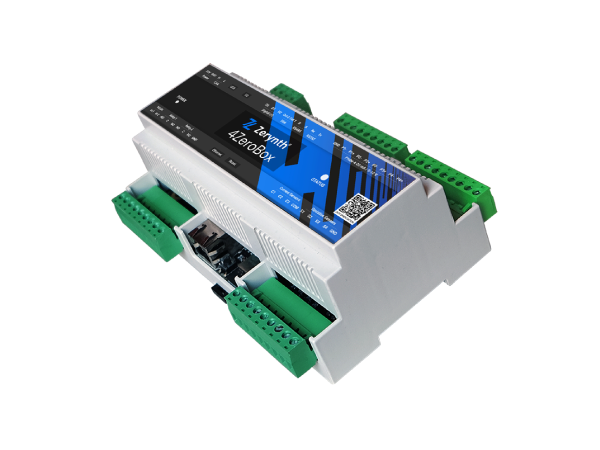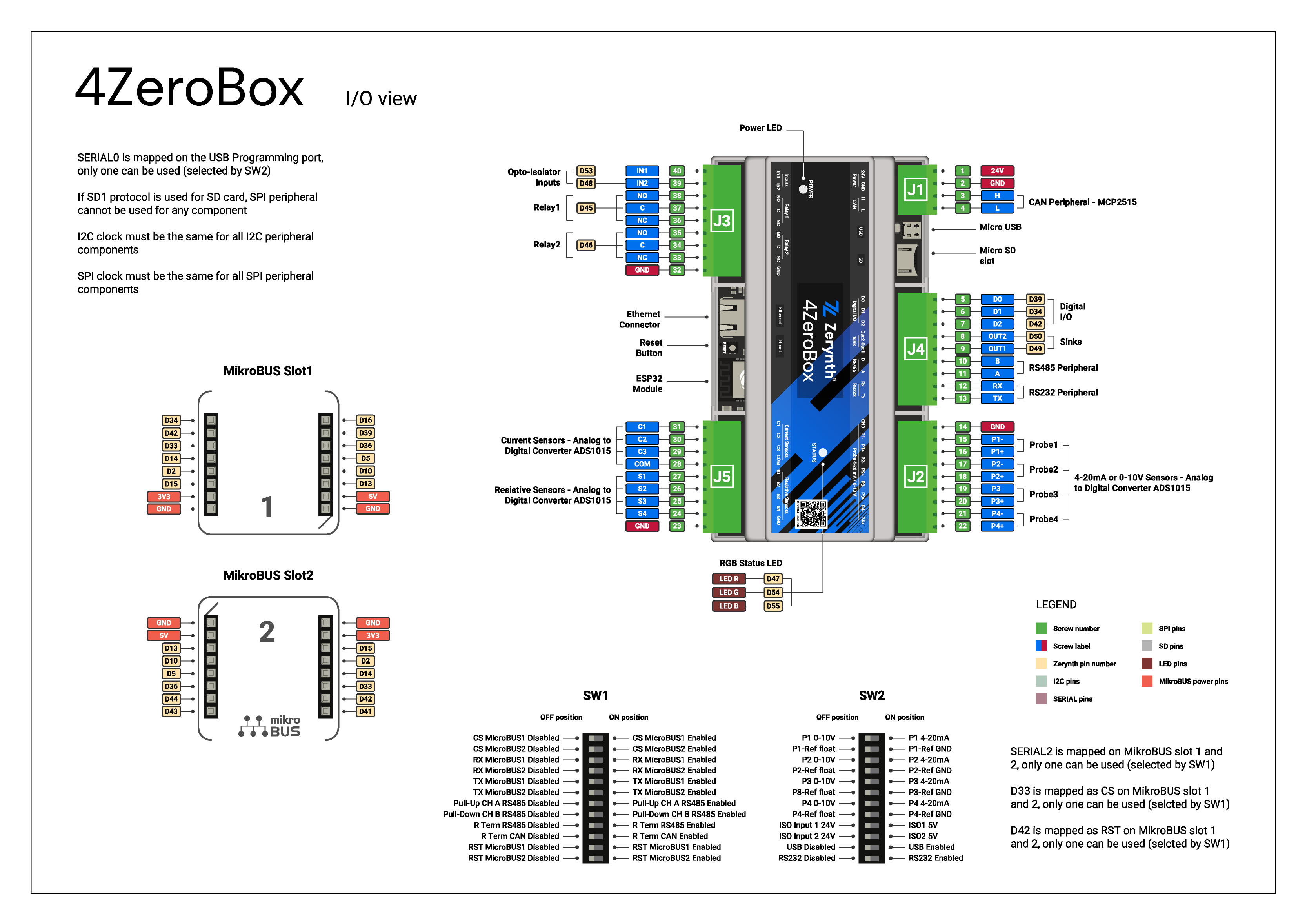4ZeroBox¶
The 4ZeroBox is a modular hardware electronic unit that simplifies the development of Industrial IoT applications allowing rapid integration with sensors, actuators, and Cloud services.
4ZeroBox mounts a powerful ESP32 Microcontroller by Espressif Systems (240MHz, 4Mb Flash, 512KB SRAM) and provides many onboard features like: a DIN-rail mountable case with industrial grade sensor channels, support for Wi-fi, Bluetooth, Ethernet, LoRa, CAN, RS485, RS232, SD Card, JTAG, I2C, SPI; last but not least, there are 2 on-board MikroBUS sockets to extend the 4ZeroBox with hundreds of MikroElektronika click boards (see “MikroBus Slots” section).

Flash Layout¶
The internal flash of the ESP32 module is organized in a single flash area with pages of 4096 bytes each. The flash starts at address 0x00000, but many areas are reserved for Esp32 IDF SDK and Zerynth OS. There exist two different layouts based on the presence of BLE support.
In particular, for non-BLE VMs:
| Start address | Size | Content |
|---|---|---|
| 0x00009000 | 16Kb | Esp32 NVS area |
| 0x0000D000 | 8Kb | Esp32 OTA data |
| 0x0000F000 | 4Kb | Esp32 PHY data |
| 0x00010000 | 1Mb | Zerynth VM |
| 0x00110000 | 1Mb | Zerynth VM (FOTA) |
| 0x00210000 | 512Kb | Zerynth Bytecode |
| 0x00290000 | 512Kb | Zerynth Bytecode (FOTA) |
| 0x00310000 | 512Kb | Free for user storage |
| 0x00390000 | 448Kb | Reserved |
For BLE VMs:
| Start address | Size | Content |
|---|---|---|
| 0x00009000 | 16Kb | Esp32 NVS area |
| 0x0000D000 | 8Kb | Esp32 OTA data |
| 0x0000F000 | 4Kb | Esp32 PHY data |
| 0x00010000 | 1216Kb | Zerynth VM |
| 0x00140000 | 1216Kb | Zerynth VM (FOTA) |
| 0x00270000 | 320Kb | Zerynth Bytecode |
| 0x002C0000 | 320Kb | Zerynth Bytecode (FOTA) |
| 0x00310000 | 512Kb | Free for user storage |
| 0x00390000 | 448Kb | Reserved |
Device Summary¶
DIN-rail mountable (9 slots)
8 to 36V Power Supply
4 selectable analog input channels:
- 4-20mA single-ended
- 4-20mA differential
- 0-10V standard
3 current transformers (non-invasive)
4 resistive sensor channels (NTC, RTD, contact, proximity, etc.)
2 opto-isolated digital inputs
2 sink digital output (60A @ 30V)
MicroSD card slot
1 Digital I/O + 2 Digital Input (3.3V)
2 NO/NC Relay (10A @ 250V AC)
CAN peripheral
Connectivity:
- WiFi IEEE 802.11 b/g/n/e/i (Client and AP mode supported)
- Bluetooth® Low-Energy
- Ethernet
Crypto Chip - Secure Hardware Encryption
RS-485 and RS232 peripherals
2 onboard mikroBUS sockets
Li-Po battery support
Li-Po battery onboard charging unit
RGB status led
Espressif ESP32 - 32bit Microcontroller 240MHz clock, 4Mb of Flash, 312Kb SRAM
Power¶
Power to the 4ZeroBox is supplied via the on-board USB Micro B connector or directly via the “24V” screw. The power source is selected automatically. Zerynth 4ZeroBox has also a JST Li-Po battery connector (3.7V).
Connect, Register, Virtualize and Program¶
The 4ZeroBox comes with a serial-to-usb chip on board that allows programming and opening the UART of the ESP32 module. The CH340 USB to UART chip is also connected to the boot pins of the module, allowing for a seamless virtualization of the device.
Note
For Linux Platform: to allow the access to serial ports the user needs read/write access to the serial device file. Adding the user to the group, that owns this file, gives the required read/write access:
- Ubuntu distribution –> dialout group
- Arch Linux distribution –> uucp group
Once connected on a USB port, if drivers have been correctly installed, the 4ZeroBox device is recognized by Zerynth Studio. The next steps are:
- Select the 4ZeroBox on the Device Management Toolbar (disambiguate if necessary);
- Register the device by clicking the “Z” button from the Zerynth Studio;
- Create a Virtual Machine for the device by clicking the “Z” button for the second time;
- Virtualize the device by clicking the “Z” button for the third time.
Note
No user intervention on the device is required for registration and virtualization process
After virtualization, the 4ZeroBox is ready to be programmed and the Zerynth scripts uploaded. Just Select the virtualized device from the “Device Management Toolbar” and click the dedicated “upload” button of Zerynth Studio.
Note
No user intervention on the device is required for the uplink process.
Resources¶
For more infos about electrical connections, and how to use 4ZeroBox with sensors and other hardware, see the user manual.
Other useful documents are:
Firmware Over the Air update (FOTA)¶
The Firmware Over the Air feature allows to update the device firmware at runtime. Zerynth FOTA in the 4ZeroBox device is available for bytecode and VM.
Flash Layout is shown in table below:
| Start address | Size | Content |
|---|---|---|
| 0x00010000 | 1Mb | Zerynth VM (slot 0) |
| 0x00110000 | 1Mb | Zerynth VM (slot 1) |
| 0x00210000 | 512Kb | Zerynth Bytecode (slot 0) |
| 0x00290000 | 512Kb | Zerynth Bytecode (slot 1) |
For BLE VMs:
| Start address | Size | Content |
|---|---|---|
| 0x00010000 | 1216Kb | Zerynth VM (slot 0) |
| 0x00140000 | 1216Kb | Zerynth VM (slot 1) |
| 0x00270000 | 320Kb | Zerynth Bytecode (slot 0) |
| 0x002C0000 | 320Kb | Zerynth Bytecode (slot 1) |
For Esp32 based devices, the FOTA process is implemented mostly by using the provided system calls in the IDF framework. The selection of the next VM to be run is therefore a duty of the Espressif bootloader; the bootloader however, does not provide a failsafe mechanism to revert to the previous VM in case the currently selected one fails to start. At the moment this lack of a safety feature can not be circumvented, unless by changing the bootloader. As soon as Espressif relases a new IDF with such feature, we will release updated VMs.
Secure Firmware¶
Secure Firmware feature allows to detect and recover from malfunctions and, when supported, to protect the running firmware (e.g. disabling the external access to flash or assigning protected RAM memory to critical parts of the system).
This feature is strongly platform dependent; more information at Secure Firmware - ESP32 section.
Zerynth Secure Socket¶
To be able to use Zerynth Secure Socket on esp32 boards NATIVE_MBEDTLS: true must be used instead of ZERYNTH_SSL: true in the project.yml file.
